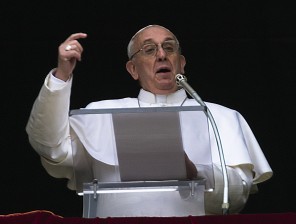VATICAN CITY – Finding himself near a Vatican exit and hearing people chanting his name outside, during one of his first days in office, Pope Francis responded with an impromptu walkabout that looks set to become a frequent occurrence.
The new pope spent several minutes shaking hands and cuddling children, apparently taking as much time as he wanted, as security officials and Swiss Guards looked on nervously.
“Security detail in fibrillation, faithful delirious” is how the Italian daily Il Fatto Quotidiano described the scene.
The papal bodyguards had better get used to it.
From the very start of his papacy, the first Latin American pontiff has exhibited a common touch and served notice that he will not tolerate life in a security bubble cut off from ordinary people.
Vatican spokesman Federico Lombardi said security measures cannot be imposed on the pope.
“If the pope says, ‘I want to go greet these people’, the pope goes ahead, and the security people go along,” Lombardi said, adding that the bodyguards would have to “show flexibility”.
“This is something brand new” compared with the behaviour of Francis’s shy, reserved predecessor Benedict XVI, Lombardi said.
“You have to respect the pope’s personal style,” Lombardi said. “The security officials are aware that it is not they who are running the show but the pope, and they have to adjust to that.”
Responsibility for papal security is shared by about 100 Swiss Guards — the traditional papal security coterie — plus about 100 Vatican police and another 140 Italian police who maintain a round-the-clock patrol at the edges of the tiny city state.
Regardless of their charge’s personal style, security personnel must always seek a balance between access and protection.
Popes, at least in the modern age, have always been vulnerable at key moments when they minister to the faithful — notably when a general audience or a mass is held in St Peter’s Square or in the vast basilica.
Francis will set an enormous early test for his security detail on Tuesday when tens of thousands of pilgrims are expected to pack the famous square for his inaugural mass — and he plans to weave his way among them for at least a quarter of an hour.
It was here that a right-wing Turkish extremist, Mehmet Ali Agca, shot John Paul II at close range in 1981, an assassination attempt that remains seared in the collective memory.
Like Francis, John Paul II also craved contact with the people, Lombardi noted.
“Everyone remembers how many times John Paul II broke the rules in order to meet people directly, even in situations that could be risky or unpredictable,” Lombardi said. “That was his style. He wanted to do that and had to be able to do that. Those in charge of security did the best they could.”
The attack prompted the addition of armoured plating and bulletproof glass to the iconic popemobile, and pilgrims wanting to attend the weekly general audience have had to pass through metal detectors ever since.
Lesser breaches have also led to new layers of security.
In June 2007 papal bodyguards had to overcome an apparently deranged German man who jumped a barricade and tried to board Benedict XVI’s white jeep, also in St Peter’s Square.
Security officers immediately wrestled the man to the ground.
Two years later, before the start of Christmas midnight mass in St Peter’s Basilica, a mentally unstable Swiss-Italian woman tackled Benedict, causing him to fall on the floor, though he quickly recovered.
On similar occasions following that incident, several more security agents could be seen flanking the pope along his path — widened to add more distance between him and the congregation.
“Security officials are at the service of the pope,” Lombardi said, adding that they will have to adapt “to the pastoral style that the pope uses”.
But they like to err on the side of caution when they can.
On Tuesday for Francis’s inaugural mass, at least 3,000 security personnel will be deployed including sharpshooters.
Hundreds of plainclothes officers are to be scattered within the expected crowd of a few hundred thousand people, filling St Peter’s Square as well as the main artery leading up to it.
